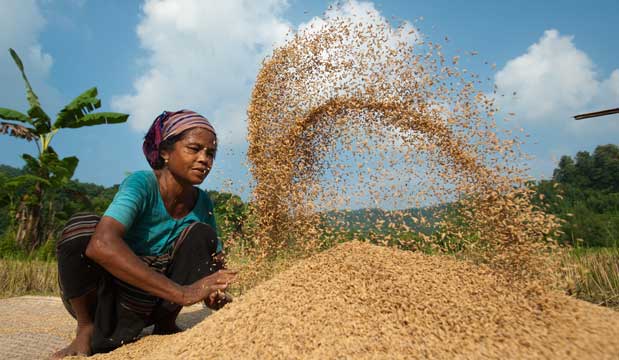By Tanzina Dilshad, GIS and Remote Sensing Specialist, BCAS
GIS and Remote Sensing Analyst, BCASThe impacts of climate change are not gender-neutral. Therefore, it is urgent that policymakers understand the gendered vulnerabilities of climate change and integrate the understandings in policies and other initiatives related to climate-change adaptation. Climate-change policies and programmess need to be informed by how men and women are differently impacted by climate-related hazards, and thus the adoption of adaptation and mitigation strategies in geo-physical contexts need to take into account gender-determined needs and priorities.
Earlier, gender was not a salient issue in climate-change policies. Women’s roles in communities were not formally recognised or accounted for in mitigation, adaptation and relief efforts. Women’s knowledge about ecosystems and their strategies, experiences and skills for coping with natural disasters and water shortages were often ignored (Dankelman, 2002). Strategies and policies for coping with climate change often neglected the gender dimensions of climate change in the prevailing gender climate-change agenda. Women were poorly represented in planning and decision-making processes in climate-change policies, limiting their capacity to engage in political decisions that could impact their specific needs and vulnerabilities (Enarson, 2002, Climate Alliance, 2005).
 As women are more involved in small-scale agriculture in than men in Bangladesh, they are also more exposed to the elements – heat, rain, cold and wind.
As women are more involved in small-scale agriculture in than men in Bangladesh, they are also more exposed to the elements – heat, rain, cold and wind.
Photo credit: Alex Treadway/ ICIMOD
However, gender equity is now considered a cross-cutting issue and it has received due attention in sustainable development movements and in many international treaties and guiding principles. A reflection of that growing recognition has also become noticeable in national-level policies and programmes.
It is intriguing that gender equality is a guiding principle in Bangladesh’s National Adaptation Programme of Action, 2005 (NAPA) designs. NAPA acknowledges women as one of the most vulnerable groups who are impacted by climate change. However, information about the causes and solutions to climate-induced gender disparities are still insufficient and need to be updated. Bangladesh has prepared a Climate Change Strategy and Action Plan (BCCSAP, 2009), which also acknowledges women’s vulnerability to climate change. The plan has proposed a project (T1P9) for protecting the livelihoods of vulnerable socio-economic groups, including women. However, as alleged by many gender activists, it is inadequate in reducing women’s vulnerabilities. There is no attempt cited in the plan to integrate gender into broader development policy frameworks as a cross-cutting issue; rather, the dispersed initiatives are unlikely to ensure gender equity in every sector of the economy (Baten and Khan, 2010). Both NAPA and BCCSAP address women as a vulnerable group but fail to explore women’s agency when determining their capacities for coping with and adapting to climate change’s impacts. Thus the need for capacity building of women as actors is not addressed in those programmes and plans.
A review of the BCCSAP (2010), the National Environment Policy (1992), the National Plan for Disaster Management 2010–2015 (2010), the Health Policy (2011), the National Women Development Policy (2011) and the Bangladesh National Strategy for Maternal Health (2001) reveals that climate change and differentiated gender impacts have not been recognised in their studies. Policy objectives related to climate change and gender are generally addressed as mutually exclusive issues; and existing policies do not consider gender-specific operational activities. The only policy that includes gender-based considerations for climate adaptation is the Poverty Reduction Strategy paper (2005); but the operational activities under this policy have not yet fulfilled these objectives. Climate-change policies generally recognise women as vulnerable, but operational responses that take the fact into account have not yet been established. In policies related to gender and reproductive health, the impact of climate change is not considered, with the exception of the National Women Development Policy, which briefly promotes women’s roles in environmental management and the importance of ensuring facilities for and the security of pregnant women in the event of natural disasters (Shabib and Khan, 2014). There is thus a need for policymakers to consider gender-responsive initiatives in policies and programmes in all sectors.
This discussion shows that gender has not yet been mainstreamed in Bangladesh’s climate- change policies and programmes. This needs to change because gender-mainstreaming is urgently needed to ensure equitable participation of women throughout all stages of adaption processes, which will pave the way for drawing on and valuing women’s unique storehouse of knowledge and experiences and will build on their capacities as well.
References
- Dankelman, I., 2002. Climate Change: Learning from Gender Analysis and Women’s Experience of Organizing for Sustainable Development. In R. Masika (ed), Gender, Development and Climate Change. Oxfam publication, Oxford
- Enarson, E., 2002. Environmental Management and Mitigation of Natural Disasters: A Gender Perspective. Panel II, Commission on the Status of Women, 46th Session, March. UN, New York, 2002.
- Climate Alliance, 2005. Climate Alliance 2004/2005 Annual Report. Climate Alliance, Frankfurt am Main. p 74.
- Baten, M. and Khan, N., (2010). Gender Issuue in Climate Change Discourese : theory versus reality. UnnayanOnneshan.
- Shabib, D. and Khan, S. (2014). CASE STUDY Gender-sensitive adaptation policy-making in Bangladesh: status and ways forward for improved mainstreaming. Climate and Development, 2014 Vol. 6, No. 4, 329–335, http://dx.doi.org/10.1080/17565529.2014.951017
